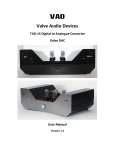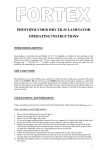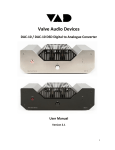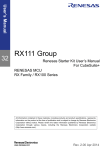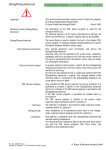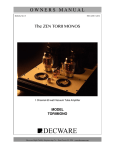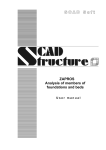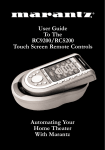Download Takumi K-70 Owner`s guide
Transcript
Left Channel Off On Right Channel Takumi K-70 DC Reactor Power Supply Takumi K-70 Owner's guide Contents 1. Introduction T1 Fuse replacement 2. Brief description T2 Tube replacement 3. Getting to know the parts T3 DC cable adjustments 4. Placement and Layout T4 AC voltage adjustments 5. Power requirements Sections T1 thru T4 provide information specifically for qualified and authorized service personal. Do not attempt these adjustmets! 6. Connecting and set-up 7. Powering up 8. Powering down and disconnection A1 On driving loudspeakers 9. Maintenance and cleaning A2 On power supplies 10. Trouble shooting A3 The meaning of “Takumi” 11. Conditions of warranty 12. Specifications Section A1 thru A3 are included for aditional interest only. 1. Introduction 2. Brief Description Congratulations on your acquisition of the Takumi K-70 power amplifier system. This is a truly special amplifier and due to several uncommon attributes, complete study of this manual is necessary before proceeding with the installation of the K-70. We would like to acknowledge your purchase and extend our hand in gratitude. The Takumi K-70 power amplifier system is delivered in a three chassis format, a pair of mono amplifiers and a single, separate power supply unit. As a variant of the single ended amplifier family line the K-70 generates a great deal of heat, even when coasting at zero volume. This amplifier makes use of six vacuum tubes and sixty eight power transistors, all woven together in a unique and marvellous form. Given suitable installation, the K-70 will provide years upon years of illuminated and exhilarating listening sessions. Thank you again for your choice of this Robert Koda product. Some of the key features that make this amplifier spectacular include: ● Cordially, The Robert Kŏda Team. ● ● ● IMA LT U plifile m A ● The ability to extract total performance from the loudspeakers by being able to drive the loudspeakers. We invite you to review section A1 to gain a fuller understanding of our interpretation and the importance of drive. A flexible and versatile input arrangement where various inputs including voltage mode and current mode, single ended or balanced may be inter-changed with out compromise. Freedom from “power supply” sound. Not just by building a “bullet proof” power supply but by removing the very interaction between the power supply and the amplifier proper, we have solved an important issue well known to blemish an amplifier’s sonics. Flexible tripple chassis layout arrangement to facilitate short cable runs. A critical selection of parts, internal wiring and layout to extract the finest possible result. And of course, the Sound ! Takumi K-70 Owner's guide 1/2 3. Getting to know the parts Balanced L J K70’s DC power supply. Note the key position for aligning the connector when making the connection. K Hi-Z and cable carry dangerous voltages and should be treated with great care. SE Type 5842 Lo-Z H BAL F Type 5842 B Warning sign – indicating that the DC connector INPUTS A DC power connector for connection to the Single Ended (Mono amps) G I Made in Japan C Positive speaker terminal. D Negative speaker terminal. E Cautionary sign – The speaker terminals are floating at a DC potential and connection precautions must be fully understood before making connections! Takumi K-70 B F Vacuum tube – Triode type 5842 A G Vacuum tube – Triode type 5842 H Hi-Z / Low Z switch. The general setting is Hi-Z C DC POWER INPUT SPEAKER + I Balanced / SE select. Set to correspond with the connector you hook up to. Caution. Risk of electrical shock. Do not open. CAUTION! E Serial number - DC FLOATING. See manual before making connections. J XLR type balanced input. Pin 2 wired “Hot”. K Interphase transformer. This devise may be removed and replaced with the optional types for use with current mode input sources or other possible configurations. L RCA single ended input socket. 3 Takumi K-70 Owner's guide D (Power supply front) A Power on / off switch. When the switch is in the off position, there is almost no power consumption. Left Channel On A B Left channel pilot light – Indicates that the B left channel primary supply transformer is active. C Off Takumi K-70 DC Reactor Power Supply Right Channel C D Right channel pilot light – Indicates that the right channel primary supply transformer is active. D Handles. May be used as grips when moving the power supply. (Power supply rear) A IEC type AC power inlet. B Voltage setting indicator. Please ensure your AC supply is of the same voltage as this marking indicates. C Right channel DC outlet. Note the key position for aligning the connector when making the connection. D C B 230V F A E D D Warning sign – indicating that the DC connector and cable carry dangerous voltages and should be treated with great care. E Left channel DC outlet. Note the key posi- tion for aligning the connector when making the connection. F Warning sign – indicating that the DC connector and cable carry dangerous voltages and should be treated with great care. Takumi K-70 Owner's guide 3-2 4. Placement and layout The triple chassis configuration adopted in the K-70 allows extra flexibility in the layout possibilities for your rig. The pair of mono amps are designed to be placed on the floor or better, on a gorgeous plinth to enhance beauty and provide subtle but worthwhile sonic improvement. By no account should these amplifiers be located in a concealed space as the heat build-up will shorten the amplifier’s life. Please be sure about this as such damage is not covered under guarantee. The mono amps may be placed in the general mode, with the vacuum tubes and connectors facing downward and the edges of the two thick aluminium plates forming the amplifier’s “feet”. The whole unit may then be rotated 90 degrees or even 180 degrees to assist in getting the neatest or shortest cable runs between the amplifiers and loudspeakers. 4 Takumi K-70 Owner's guide As an alternative, the amplifiers may be placed in the inverted mode where the vacuum tubes and excreta become visible. This mode may further reduce cable lengths and certainly allows for easier connectivity. If you choose the inverted mode, please use the four feet provided to lift the amplifier off the support structure. The feet are important because they prevent the top (now bottom) from being scratched, promote essential cooling and cut down vibration. Bear in mind that as the vacuum tubes become fully exposed in the inverted mode and since these devises get hot, are fragile and use high voltages, this mode may not be suitable for all environments particularly those with children and pets about. Installation the feet instructions for when the amplifier is used in the inverted position. Note the twelve hex screws holding the top cover onto the main amplifier chassis. Looking at each line of four screws, remove the central two screws only from each row such that a total of four screws have been removed. Place the feet into position with the flat side of the foot sitting on the amplifier. Use the four long hex screws provided to secure the feet / cover to the amplifier’s chassis. Note: The power supply is not designed to stand inverted and so the feet are not used in this fashion with the power supply unit. If you would like to use the feet with the amplifier’s mounted in the standard position, simply lift the front / rear and let the faceplate rest in the groove of the foot. Such may also be used with the power supply unit. Takumi K-70 Owner's guide 4-2 DC supply It should be comforting to know that those long power cables connecting the power supply to each mono amplifier do not disturb sound quality. Feel free to place the power supply unit at any distance from the mono amps. Should you require a custom length of DC power cable, we will be delighted to build that for you. The power supply generates moderate amounts of heat and requires good ventilation space. If insufficient ventilation is provided, the internal thermal fuses in the transformers may melt and the transformers would need to be replaced. Not wishing this to occur we have also placed a thermal switch in the heart of the power supply that will shut down the power supply if the chassis becomes too hot. Another consideration to be addressed is one of mechanical vibration. The magnetic components in the power supply “purr” along as the unit is delivering well over one horse power from the moment you turn the power on. Good placement and perhaps the use of a dedicated audio stand, isolating and lifting the unit well clear will be of great benefit. DC reactor simply explained: Our power supply uses eight power inductors to store energy in the form of a magnetic field. Such inductors are called DC reactors and hence the name. One aspect to be aware of though, is that magnetic “spillage” may induce a buzzing sound into other magnetic sensitive components so we advise – Do not place your turntable on top of the DC supply! On another note, one other highly respected amplifier manufacturer* notes:” Their use in power amplifier supplies is an indication that the manufacturer has an unusually strong commitment to performance.” We think so too! *Nelson Pass with kind permission. 4-3 Takumi K-70 Owner's guide Placement cautions. Locations of high humidity, dust and plentiful sunlight are not recommended for any of the K-70’s components. Also take care to place the units such that water / liquids and other objects may not spill into the electronics! Beachfront accommodation is not recommended for the K-70 as salt build up, combined with the heat moisture may dramatically reduce life span. 5. Power requirements While the K-70 does not require a particularly clean AC power source to operate at its best, it does consume about 900W from the moment the power switch is turned on. This amounts to a current draw of about 4 or 5 amps for 220 to 240V models and twice that for 100 to 110V models. Please note that this unit is NOT auto voltage selecting! Use only an AC source of a voltage that corresponds with the AC voltage setting of this amplifier – clearly marked on the back of the DC power supply unit. AC power cable This amplifier is not supplied with an AC power cable. The AC cable used with this amplifier should be rated at 10 amps or greater, must be earthed and comply with the safety standards of the country where used. If you have any doubts or concerns regarding suitable AC power cables, please consult your local distributor. Takumi K-70 Owner's guide 5 6. Connecting and set-up (Mono Blocks) It is essensial that the K-70 is powered off completely before wiring or re-wiring. Speakers Important notice: The K-70 has DC floating outputs. This means you need to take some special precautions otherwise you may destroy the loudspeakers you have connected. The precautions are really very simple. ● ● Never allow one of the speaker wires to touch the chassis work of the K-70 or any other conductive object other than the K-70’s speaker terminal. Only connect passive loudspeakers to the speaker terminals. This means that any devise or loudspeaker that has its own AC power chord, such as active subwoofers and loudspeakers with internal active subwoofers, may NOT be directly connect ed to the K-70. If you have an enquiry in this regard, we will be happy to assist before you make the connections! Electrostatic loudspeakers also fall into the category of not connectable but under certain circumstances, depending on make and model, may be safely connected. If your speaker cables are of a stiff nature, it may be a good idea to provide some strain relief to allow the cable ends to be correctly fastened into the K-70 speaker terminals such that the chances of a speaker wire jumping out and touching the K-70's chassis are minimised. Source component connection. The K-70 has four input modes; Single ended and Balanced voltage driven, plus Single ended and Balanced in the current mode. Current mode pre-amplifiers are presently rare so most installations would use the practically universal voltage mode. You can choose between using the single ended or balanced inputs with confidence. The best performer will be dictated only by your source components characteristics. 6 Takumi K-70 Owner's guide Connect either to the balanced or single ended input socket But not both at the same time! Set the Bal/SE switch into the appropriate position and set the Low- Z / Hi-Z switch into the Hi-Z position. These are locking switches to prevent accidental adjustment. Simply lift the lever of the switch toward you and then toggle it to the selection required. Note – Don’t adjust the switches or make connections while the amplifier is on! Recommendation – If you live in an area where the atmosphere is corrosive, it may be wise to shelter un-used input sockets from the environment by plugging in a “dummy” connector or other socket protection caps. For reference: The balanced input is wired as follows: Pin 1 is Ground, Pin 2 is Hot and Pin 3 is Cold. Using Current Mode inputs For the current mode inputs to work correctly the K-70’s input interphase, mounted on an octal socket between the two vacuum tubes needs to be swapped out for a different one. This unit is available as a separate accessory. DC Power connector The DC power connector connects each mono unit to the power supply. We have used connectors here of military application origin (that should explain their color!) since the connectors carry some 11 amps of continuous current and a high 350 volts. Align the key of the connector with the key of the socket, push until the connector and socket meet and then rotate the connector’s outer ring until the connector fully locks into the socket. There is quite a bit of thread so it takes a little effort! We have used a right angle connector on the amplifier side and a straight connector on the power supply side. If you find that the right angle connector is protruding in an inconvenient direction, it is possible to adjust this – Please see the technical section T3 for details. Note – The power supply will not switch on unless all DC power connections are made for both amplifiers. We have done this to contribute to safety. Connecting in the power supply It may be most practical to first make DC cable connections to the main amplifiers. Next connect up the DC cables to the power supply and finally, make the AC connection. May we remind you that the AC power cable must be earthed for safety reasons. Also always remember that the DC cables carry lethal power. If any part of the connector or cable appears to be damaged, please return the cable to your distributor for replacement. 7. Powering up Before the moment of powering up, it’s a good idea to do one more check – All connections good, all switches in the correct position. Vacuum tubes nice and snug in their sockets. OK. The factory set voltage of the power supply corresponds to your AC supply voltage? OK. Grab the rotary power switch on the power supplies front panel and turn it onto the On position. You should be greeted by the warm illumination of two amber neon lights. The power supply will purr and there may even be a few “clicking” sounds during the first few seconds. But no sound should emanate from the loudspeakers. If nasty sounds do emanate from the loudspeakers, power down immediately and seek advise from the trouble shooting section. If all is good, the tubes will reach operation within 60 seconds and its time to settle down to your first musical journey with this wonderful amplifier but keep an occasional eye on things. It is wise to check the temperature of each mono amplifier’s heat sinks as well as the power supply’s temperature. The power supply should be warm to the touch with the front panel, particularly around the neon lights being notably warmer. This is not due to the lights but rather the power diodes bolted onto the inside of the panel. The left and right heat sinks on each mono amp will be at a somewhat different temperature. You wouldn’t want to leave your hands on them all day but if it feels like they are burning you, then the amplifiers need to be re-located to provide better cooling. Important – The K-70 warms up to optimal sound quality levels within an hour or so. Do not leave the amplifier on needlessly and do not forget the unit on whilst not under your direct supervision. 8. Powering down and disconnection Powering down is straight forward; simply turn off the power switch. However, should you want to power up again, please wait at least one minute before doing so. Quick repetitive toggling between on and off can upset or damage the vacuum tube power supply. Note:The short time lag between turring the unit off and the actual swith off is normal. Disconnection First turn off the unit and then remove the AC power cable. Wait at least 5 minutes before continuing with any further system disassembly. This gives the vacuum tubes opportunity to cool down and the condensers time to at least partly discharge their energy. 9. Maintenance and cleaning. Before undertaking any cleaning operation, the system should be powered down and allowed to fully cool. To be safe, remove the AC power cable from the DC power supply. The finned heat sinks are best cleaned with a paint brush with very long hairs for reaching the deep crevices. Treat cleaning with an air brush with great care as they are capable of blowing the dirt and dust into places where these matter would not be appreciated, like circuits and junctions, where cleaning then by degrees only becomes more difficult. Chassis work may be dusted first with the above mentioned paint brush and further cleaned with a soft cloth, moistened with a solution of warm water and a very mild mix with soap or dish washing liquid. Maintenance - General. In general no maintenance is required. Of primary concern is the operating environment the K-70 is placed in as, if ill placed, the otherwise very long life-span of this machine may be compromised. Two specific areas of maintenance however include the vacuum tubes and fuses. These parts however are not user serviceable and their replacement should only be undertaken by suitably qualified persons. Takumi K-70 Owner's guide 7/8/9 Maintenance-Fuses After many cycles of use, the fuses may melt simply because they have weakened over time. To avoid this from occurring at an inconvenient time, we recommend a bi-annual fuse replacement. Important – Do not use anything other than the prescribed fuse of identical rating. Be absolutely sure to put the correct fuse into the correct socket. If a fuse has melted and the subsequent replacement melts immediately after replacement, disconnect the power supply from the AC supply swiftly and make preparation as the K-70 will need professional help. Vacuum tubes How long do the vacuum tubes last? It’s rather like the proverbial question, “How long is a piece of string?”. But we will try to shed some light onto this topic. Generally the tubes in the K-70 will last a very long time. This is because they are operated conservatively (not driven hard) and they are excellent tubes to begin with. A very long time depends on how much you use the amplifier but based on a calculation of three hours use daily, we estimate five to twenty years and quite probably 20 to 50 years for the rectifier tubes. But, as things go, unexpected failures do occur and they can occur at any time. In the event that a tube needs to be replaced it is paramount that the tube is replaced only and ONLY with the same part in the case of the K-70. These tubes are: Type 5842 for the mono amplifiers, two pieces each and Type 6X5 for the power supply, two pieces. Tube swapping for other types is forbidden in the K-70 and not only invalidates the warranty but is almost certain to cause permanent damage to the amplifiers and loudspeakers. Please be careful! 9 Takumi K-70 Owner's guide The type 5842 tubes include the 417A tubes family and the more obscure model denomination F-55788. Selections from Amperex, Raytheon, Tungsol and the ever-popular Western Electric with their 417A offering, all offer a range of alternatives. The Raytheon 5842 is selected for shipping with the K-70 due to its original military target market requiring hardier tube units and for Raytheon’s strong sonic performance. We will be pleased to assist if you need further advice on the topic of vacuum tubes. On the subject of liquid tube enhancers, judicious regard should be given to the use of these potions and each behave with characteristic dissimilarity so it is difficult to generalise any concern. Some liquids may age and harden over time and affect variances in tube contact performance. It would be up to the individual listener if this is a required result. Some liquids deal with the micro-fissure aberrations of a tube’s pins and may, themselves, be conductive in nature in order to do so. Should these conductive materials be smeared accidentally to areas between the pins then short circuiting across the pins may occur. What ever you do, don’t bend the tubes pins as this can compromise the vacuum within the tube and render the devise sadly dysfunctional. 10. Trouble shooting One or more neon not lit. In this case at least one channel will not be producing any sound and the corresponding fuse has melted. The power supply suddenly turned off. The DC power supply is equipped with thermal detection. If the sensor location exceeds 70 degrees, the power supply will automatically turn off and switch back on again when the temperature drops by about 20 degrees. Both neons are lit but there is no sound. It is possible the fuse for the vacuum tube part of the amplifier is melted and requires replacement. A buzzing sound can be heard from one or both speakers. The sound has disappeared on one or both channels but all indicator lights are still operational. Each mono block has thermal sensors coupled to both the left and right flank heatsinks. If the amplifier is too hot, then the thermal Power down the amplifier and remove the sensors will trigger and shut down only the sources’ interconnect cables from both mono heat generating portion of the amplifier. amplifiers such that the amplifiers are only Normal operation will be restored automatically connected to the loudspeakers and the DC once the temperature has dropped by about 20 power supply. Power up again and check the degrees. buzzing sound. If the sound has disappeared then the source of the problem is either If thermal triggering has occurred, the source component / pre-amplifier related or amplifier(s) should be re-located for better as a result of something called a ground cooling. loop. The best way to cure the ground loop problem is to use the K70’ s balanced inputs, driven by a balanced source. A buzzing sound can be heard from the DC power supply. This is normal but if you have noticed a recent increase it could be due to several possibilities. The positioning of the power supply in relationship to hard surfaces and room modifications as well as listening position all have some affect. If these conditions have not changed but the power supply has become really noisy, there is a chance that one of the transformers or chokes is miss-behaving and professional help will be needed. A big crackling sound came from the speakers when I turned the amplifier on. Check that one of the speaker wires has not become adrift and made contact with the amplifiers chassis. When this occurs, massive DC is passed into your loudspeaker and this DC will almost certainly damage the loudspeaker’ s woofer. Takumi K-70 Owner's guide 10/11 11. Conditions of Warranty The Robert Kŏda Takumi K-70 is guaranteed for one full year from date of purchase, parts and labour, against any breakdowns or component failure. Failures after this period will be treated on a case by case basis and we will carefully examine the circumstances with an aim to keep repair costs out of the customer’ s pocket. Conditions of use Robert Kŏda LLC Japan disclaims any responsibility in case of damage or injury directly or indirectly due to any misuse, incorrect manipulation, or non-observance of red warnings and/or advice formulated in this entire manual. Any unauthorised intervention on or in the Robert Kŏda Takumi K-70 or any failure due to one of the situations described above will render this warranty void. Assistance If you have any difficulties, enquiries or simply suggestions, please feel free to contact us by e-mail at: [email protected] We welcome mail correspondence and our address is: Robert-Kŏda LLC 1-9-4 Azusawa Itabashi-Ku Tokyo 174-0051 Japan Now that we have reached the end of the general manual (those so inclined may like to proceed to the technical section), we would like to wish you countless hours of sheer musical pleasure with your new Takumi – K-70 amplifier. In fidelity, Robert Leslie Koch 11 Takumi K-70 Owner's guide 12. Specifications DNA Single Ended Class A1 hybrid power amplifier with separate power supply. Output power Approximately 70W. Power delivery maximised for 3 to 7 ohm loads. Gain Input impedance Output impedance Signal to Noise Ratio Power response Power consumption Size Weight Operating environment 25.5dB SE in or balanced in, voltage mode. 10V/mA in current mode. 30K Ohms, Voltage mode, 50 ohms current mode. Less than 0.07 ohms 20 Hz to 20Khz. Greater than 115dB A weighted at nominal output. Less than 5Hz to greater than 200KHz. 900 Watts at any volume into any load. 380mm wide, 256mm high, 500mm deep (each of 3 units) Power supply: 40Kg Mono amps: 20Kg each Operating temperature 0 to 35 degrees Celsius. Altitude sea level thru 3000m above sea level. Storage temperature –20 to +50 degrees Celsius. Specification subject to change without notice. 12 T1. Fuses T2. Tube replacement To prevent fire and unsafe conditions in event of failure, replace fuses with only those indicated. All fuses are 3AG type, 31.8 by 6.4mm size, slow blow types. Fuse rating and function are as follows: Fuse. Region 220 to 240V A B C D 6A, 250V 200mA, 250V 1A, 250V 6A, 250V Region 100 –120V 10A, 400mA, 2A, 10A, 125V 125V 125V 125V Functions A B C D Right channel high current supply. Vacuum tube supply. Solid state relay driver power supply. Left channel high current supply. All fuses are located in line with the primary windings of their respective power transformers. All system fuses are located in the DC supply unit and may be accessed after removing AC power and the unit’s top cover. We have carefully selected these tubes for use in the K-70. While there may be noticeable differences between different brands of the same tube type, tube type swapping is not recommended. The type 5842 vacuum tube may only be replaced with a type 5842 or 417A. Failure to do so will result in damage to both the amplifier and possibly, the attached loudspeakers. The 6X5 might be replaceable with variants, not of identical type but ONLY at the owner’s risk. We categorically specify type 6X5 / CV574 for the use in this product and use of any other tube will render the warranty void. Since the equipment has been modified, safety compliance may not be satisfied. For technical interest only, the 6.3 volt filament supply for the rectifier tube is capable of delivering up to 3 amps. T1/2 Takumi K-70 Owner's guide T3. DC cable configuration. The cable itself is four-core each of a 3.5mm diameter and the cable overall 600V rated and double sheathed. Colour assignment is: Red; 350V line @ 50mA. Green; ground return and chassis earth. White; Negative 32V line at 11 amps Black; return line for white. This cable connects to chassis only at the amplifier end. DC connector adjustment. Unscrew the collar and slide it down the cable. It may be desirable to adjust the DC connector terminating onto the power amplifier such that the right bend faces a different degree. This may be accomplished as illustrated. The cable can be quite heavy and the connectors a little slippery so it might take a few moments to re-assemble the connector. Important: Ensure there is no undue strain that might compromise termination of the wires onto the connector pins. The sides should now freely drop away. Loosten the cable clamp. Unscrew the cable clamp and slide Re-atatch the sides to direct the required cable it down the cable. degree. Replace and secure parts. Note the new key position. Takumi K-70 Owner's guide T3 T4. AC voltage adjustment If the amplifier needs to be set for a different country’s AC voltage system, this may be easily undertaken by qualified personnel whom follow necessary precautions. Unplug the DC supply completely and allow 5 minutes cooling time. Turn the DC supply upside down and place it on a suitable non scratch surface. Remove the bottom cover and locate the PCB as shown. 120V operation Bridge Orange / Blue. Bridge White / Black. Fused AC to Blue. 240V operation Bridge Orange / Black. Fused AC to Blue. Double check your work and ensure all contact have been fully secured. Remember to replace all four fuses (the top cover will need to be removed) with the correct rating for the new AC voltage selection. The rear panel must be relabled to indicate the new AC voltage! DIP switches There are three groups of terminal connectors, one for each power transformer. The blue transformer mounted on the PCB will not require any adjustments. All that is required is to place the jumper tabs into the correct position and direct the fused AC wire onto the correct position. Obviously this operation needs to be repeated in the same way for each of the three groups. The fused AC wires can be swiftly identified since they are the only black wires with a RED heat shrink tube around the termination area. Setting the DIP switches DIP switches 1 thru 4’s position should be set according to the AC mains voltage used. Failure to set the switches correctly will result in improper turn on / off sequence of the power supply. For 220 to 240V SW1 ON SW2 OFF For 110 to 120V SW1 OFF SW2 ON SW3 and 4 are indifferent. T4 Takumi K-70 Owner's guide A1. Driving loudspeakers Set your speakers free! Our finding is that a critical attribute of an amplifier is one of the ability to drive the load the loudspeakers. If loudspeakers were resistors then the perfect amplifier would have existed many years ago. But loudspeakers are not resistors, they are what is known as reactive. Reactive defines a condition where the electrical currents and voltages become missaligned and are no longer simultaneous. And this happens all the time… Broadly, the more drive units, the more crossover parts, the more reactive the loudspeaker, and the less chance an amplifier has of extracting the speakers true sonic potential. Yet even a loudspeaker with a single drive unit and no crossover is reactive. Each miniscule ripple in it’s response being correlated with a reactive shifting. A reactive shifting who’s effect tricks the amplifier and is finally mirrored in a distorted way in the power supply. The K-70 is a seventy watt amplifier with a peak current delivery of perhaps 7 or 8 amperes yet it drives the most difficult loudspeakers to their peek performance with glee while other amplifiers, capable of delivering twenty times the power might not. What is going on here? Well, there are two separate and independent issues that have always been rolled up into one (AKA the power to Drive); the ability to evoke sound quality from a loudspeaker, and the ability to produce enough loudness before the amplifier reaches its limit where the loudness cannot be exceeded. Looking at the second part first, is seventy watts going to get your speakers to go loud enough? This depends on your definition of loud, your loudspeakers sensitivity (a measurement of how much noise it makes if you give it one watt), the efficiency of your room (how much sound produced by the speakers will actually reach your ears) and finally the ambient background noise level (a drop of a magazine in a library can draw a lot of attention!). Just to add a little more uncertainty to the equation, it also depends on how quickly the amplifier recovers when subject to bursts of clipping. If the amplifier recovers well then a burst of clipping distortion will pass you by without you even being aware of it! Taking a broad spectrum of home music listening environments, personal tastes and loudspeakers having a sensitivity of 84 to 90dB / Watt, we conclude that with our amplifiers, 10 to 100W will cover the most demanding situations rather comfortably. What about the ability to drive the loudspeaker? It is commonly understood that this term implies that the amplifier will be stable (safe) with a reactive load, and produce hundreds of amps into a one ohm load (excreta!) but our appreciation is one of where the amplifier is able to control the load. How do we do this? By developing the correct amplifier architecture. This is the key difference between the K-70 and other amplifiers and the overwhelming reason why the K-70 will set your speakers free! A2. Getting rid of the Sound of the power supply. Set your amplifier free! Another major advancement the K-70 has made is getting rid of the sound of the power supply and it certainly is a sonic blessing! Just like the amplifier has to drive the reactive loudspeaker to achieve sound purity, the power supply has to drive the amplifier with equal finesse. It just so happens that the reactiveness of the loudspeaker is mirrored into the power supply and this is the bulk of the two main reasons why the performance quality of a power supply has such great affect on final sound quality. The other reason of far less significance is that the power supply always carries a residual noise and this can pass into the amplifier and finally affect the amplifiers noise floor. But in reality, the noise floor is actually determined by your listening environment – Unless you live very quiet place! Robert Koda eliminated the vile power supply sound by not only building a power supply of exceptionally low residual electrical noise (our unit does purr along but that is s o met hi ng comp l et el y d i fferent) , b ut b y building an amplifier that “looks” , well like a resistor! So the power supply never feels the impact of the loudspeaker and the link is simply eliminated. Dynamic simplicity, this has been our quest! The concept seems simple enough! So why don’ t other manufactures build amplifiers that just look like a resistor to the power supply driving them? One probable reason is the failure to completely appreciate the significance of what is happening to the music, another the huge cost of implementing such circuit topologies. Another, dare we say, it requires creativeness and a will to go much further than an extra mile. Takumi K-70 Owner's guide A1/2 The meaning of "Takumi" The meaning of the Japanese character “Takumi” can be translated as “Maestro”. Our brand endeavours to build a product in the spirit of Maestro.





















